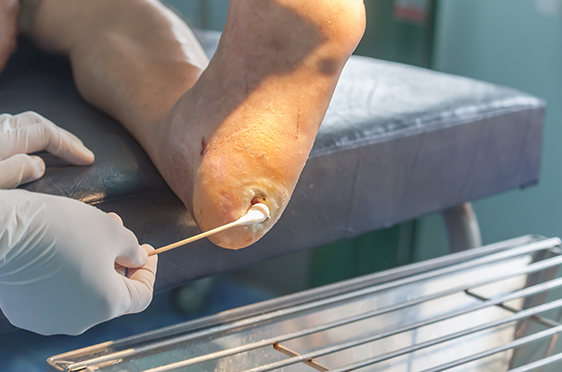Hope for Non-Healing wounds
An open sore on the foot, ankle or leg is called an ulcer. It may be shallow, confined only to the surface of the skin. Deep ulcers can involve full thickness of the skin, muscle, tendons, and bones. Ulcers are common in people with diabetes and individuals with compromised blood circulation or simply age. When an injury to skin occurs a wound can form. Naturally, when this happens, our bodies kick into gear to begin the healing process. Our own stem cells begin to divide and turns into cells needed to replace damaged cells. This process usually takes a few days to a few weeks to occur.
Healing chronic wounds can be challenging. Access and delivery of wound care are both significant problems that challenge patients suffering from chronic wounds. Lack of access to specialized wound care has resulted in amputations and an increase in mortality rates. In the United States, chronic ulcers are conservatively estimated to cost the health care system $28 billion each year as a primary diagnosis and up to $31.7 billion as a secondary diagnosis. In order to cut costs and improve outcomes, there has been a shift in the emphasis from in-hospital care to outpatient care for these wounds.
Common causes impeding wound healing are underlying infection, poor circulation, swelling and pressure on the wound area. Initial treatments for chronic wounds are to address these common causes. In addition, the wounds are typically cleaned and dressings are applied. The goal is to remove healing impediments and create a wound environment to allow our bodies to heal naturally. If these things are done adequately, a wound can be expected to be about half its size in 6 weeks. However, the cleaning of the wound, known as “debridement”, can be very painful. This leads to inadequate cleaning causing the wound to pause in its healing.
Today we use ultrasonic technology to painlessly “clean” the wound and promote healing. The use of this technology, known as “Ultramist” has reduced the need for painful “debridements” and improved wound healing outcomes.
Another reason wounds don’t heal is that stem cells in the wound can become dormant. This is known as “cellular senescence”. Their capabilities to produce new cells are reduced. Two significant reasons our stem cells become less robust is diabetes and the aging process.
There are now wound care treatments that help these sleeping stem cells to begin to divide and repair wounds again. These products take stem cells from a donated placenta or umbilical cord from live C-sections and process them to be used in wounds. The placenta and umbilical cord are no longer needed by the baby once born and in the past was discarded. It has been known that the placenta and umbilical cord has a high density of healthy harvestable stem cells but for decades the ability to harvest these cells eluded scientist. Improvements in technology have made harvesting and processing stem cells for use in wounds are now possible and beginning to be used by many specialists in wound care.
These stem cells have many capabilities when we put onto a chronic wound. They have proteins that “wake-up” our own stem cells helping wounds to heal. These products come in many varieties and must be tailored to each patient. They are painless to apply and can be done in the office. Painless ultrasonic therapy and stem cell products have changed the face of wound care today and have offered hope for patients to heal stubborn wounds.

